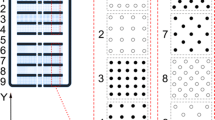Abstract
Cells change the traction forces generated at their adhesion sites, and these forces play essential roles in regulating various cellular functions. Here, we developed a novel magnetic-driven micropillar array PDMS substrate that can be used for the mechanical stimulation to cellular adhesion sites and for the measurement of associated cellular traction forces. The diameter, length, and center-to-center spacing of the micropillars were 3, 9, and 9 μm, respectively. Sufficient quantities of iron particles were successfully embedded into the micropillars, enabling the pillars to bend in response to an external magnetic field. We established two methods to apply magnetic fields to the micropillars (Suresh 2007). Applying a uniform magnetic field of 0.3 T bent all of the pillars by ~4 μm (Satcher et al. 1997). Creating a magnetic field gradient in the vicinity of the substrate generated a well-defined local force on the pillars. Deflection of the micropillars allowed transfer of external forces to the actin cytoskeleton through adhesion sites formed on the pillar top. Using the magnetic field gradient method, we measured the traction force changes in cultured vascular smooth muscle cells (SMCs) after local cyclic stretch stimulation at one edge of the cells. We found that the responses of SMCs were quite different from cell to cell, and elongated cells with larger pre-tension exhibited significant retraction following stretch stimulation. Our magnetic-driven micropillar substrate should be useful in investigating cellular mechanotransduction mechanisms.










Similar content being viewed by others
References
Y. Arakawa, H. Bito, T. Furuyashiki, T. Tsuji, S. Takemoto-Kimura, K. Kimura, K. Nozaki, N. Hashimoto, S. Narumiya, Control of axon elongation via an SDF-1alpha/rho/mDia pathway in cultured cerebellar granule neurons. J. Cell Biol. 161(2), 381–391 (2001)
K. Burton, J.H. Park, D.L. Taylor, Keratocytes generate traction forces in two phases. Mol. Biol. Cell 10(11), 3745–3769 (1999)
C.S. Chen, M. Mrksich, S. Huang, G.M. Whitesides, D.E. Ingber, Geometric control of cell life and death. Science 276-5317, 1425–1428 (1997)
C.G. Galbraith, M.P. Sheetz, A micromachined device provides a new bend on fibroblast traction forces. Proc. Natl. Acad. Sci. U. S. A. 94(17), 9114–9118 (1997)
B. Li, M. Lin, Y. Tang, B. Wang, J.H. Wang, A novel functional assessment of the differentiation of micropatterned muscle cells. J. Biomech. 41(16), 3349–3353 (2008)
T. Mizutani, H. Haga, K. Kawabata, Cellular stiffness response to external deformation: Tensional homeostasis in a single fibroblast. Cell Motil. Cytoskeleton 59(4), 242–248 (2004)
K. Nagayama, T. Matsumoto, Dynamic change in morphology and traction forces at focal adhesions in cultured vascular smooth muscle cells during contraction. Cell. Mol. Bioeng. 4(3), 348–357 (2011)
K. Nagayama, A. Adachi, T. Matsumoto, Heterogeneous response of traction force at focal adhesions of vascular smooth muscle cells subjected to macroscopic stretch on a micropillar substrate. J. Biomech. 44(15), 2699–2705 (2011)
K. Nagayama, A. Adachi, T. Matsumoto, Dynamic changes of traction force at focal adhesions during macroscopic cell stretching using an elastic micropillar substrate: Tensional homeostasis of aortic smooth muscle cells. J. Biomed. Sci. Eng. 7(2), 130–140 (2012)
I. Rabinovitz, I.K. Gipson, A.M. Mercurio, Traction forces mediated by alpha6beta4 integrin: Implications for basement membrane organization and tumor invasion. Mol. Biol. Cell 12(12), 4030–4043 (2001)
D. Riveline, E. Zamir, N.Q. Balaban, U.S. Schwarz, T. Ishizaki, S. Narumiya, Z. Kam, B. Geiger, A.D. Bershadsky, Focal contacts as mechanosensors: Externally applied local mechanical force induces growth of focal contacts by an mDia1-dependent and ROCK-independent mechanism. J. Cell Biol. 153(6), 1175–1186 (2001)
R. Satcher, C.F. Dewey Jr., J.H. Hartwig, Mechanical remodeling of the endothelial surface and actin cytoskeleton induced by fluid flow. Microcirculation 4, 439–453 (1997)
N.J. Sniadecki, A. Anguelouch, M.T. Yang, C.M. Lamb, Z. Liu, S.B. Kirschner, Y. Liu, D.H. Reich, C.S. Chen, Magnetic microposts as an approach to apply forces to living cells. Proc. Natl. Acad. Sci. U. S. A. 104(37), 14553–14558 (2007)
N.J. Sniadecki, C.M. Lamb, Y. Liu, C.S. Chen, D.H. Reich, Magnetic microposts for mechanical stimulation of biological cells: Fabrication, characterization, and analysis. Rev. Sci. Instrum. 79(4), 044302 (2008)
S. Sugita, T. Adachi, Y. Ueki, M. Sato, A novel method for measuring tension generated in stress fibers by applying external forces. Biophys. J. 101(1), 53–60 (2011)
S. Suresh, Biomechanics and biophysics of cancer cells. Acta Biomater. 3(4), 413–438 (2007)
J.L. Tan, J. Tien, D.M. Pirone, D.S. Gray, K. Bhadriraju, C.S. Chen, Cells lying on a bed of microneedles: An approach to isolate mechanical force. Proc. Natl. Acad. Sci. U. S. A. 100, 1484–1489 (2003)
Y. Ueki, N. Sakamoto, M. Sato, Cyclic force applied to FAs induces actin recruitment depending on the dynamic loading pattern. Open Biomed. Eng. J. 4, 129–134 (2010)
Acknowledgements
This work was supported in part by a Grant-in-Aid from the Ministry of Education, Culture, Sports, Science and Technology, Japan (nos. 16 K12865 and 17H02077 to K.N., and nos.15H02209 and 17 K20102 to T.M.), Naito foundation, Japan (K.N.), Takahashi industrial and economic research foundation, Japan (K.N.), and AMED-CREST from Japan Agency for Medical Research and Development, AMED (JP18gm0810005 to K.N. and T.M.).
Author information
Authors and Affiliations
Corresponding authors
Rights and permissions
About this article
Cite this article
Nagayama, K., Inoue, T., Hamada, Y. et al. Direct application of mechanical stimulation to cell adhesion sites using a novel magnetic-driven micropillar substrate. Biomed Microdevices 20, 85 (2018). https://doi.org/10.1007/s10544-018-0328-y
Published:
DOI: https://doi.org/10.1007/s10544-018-0328-y




